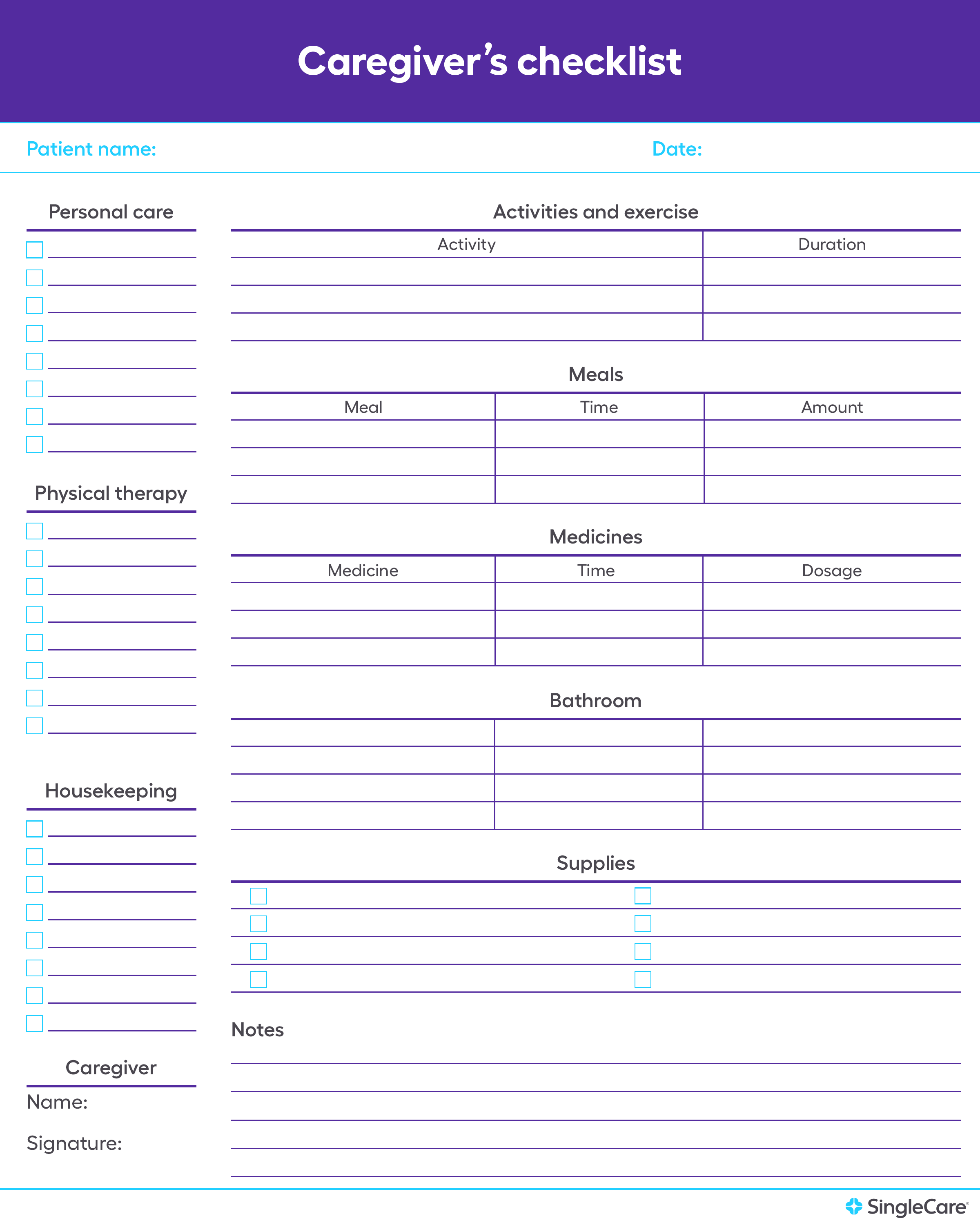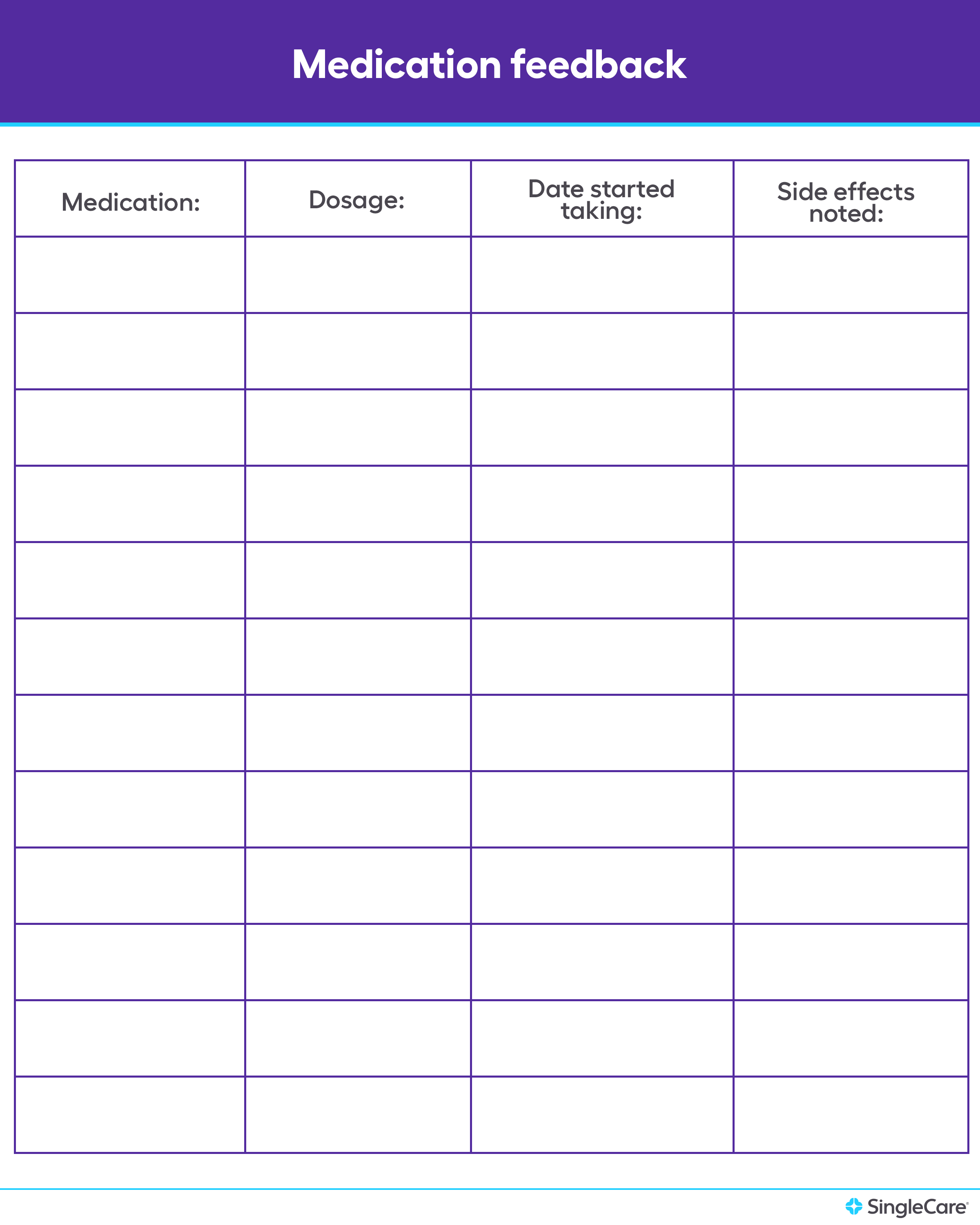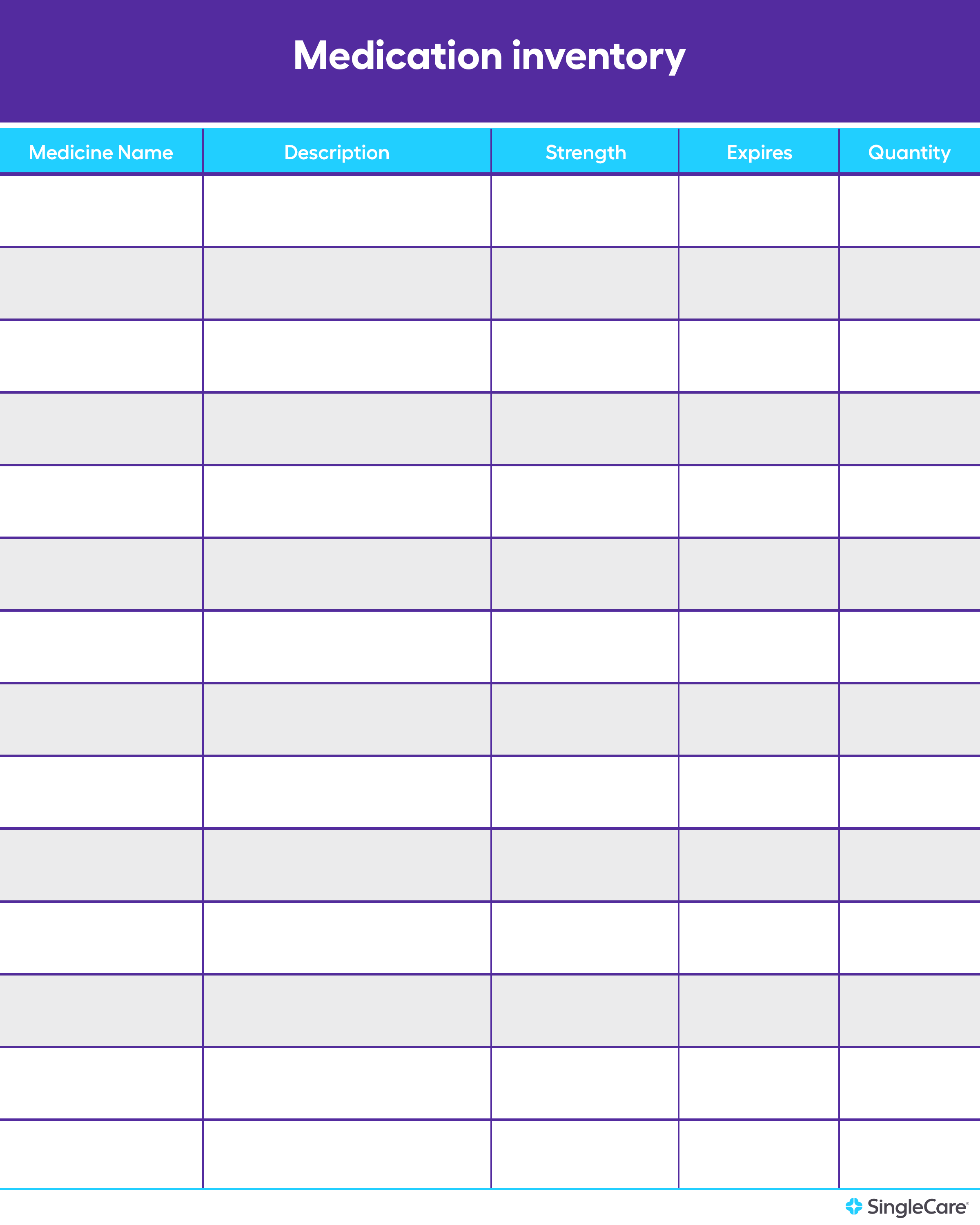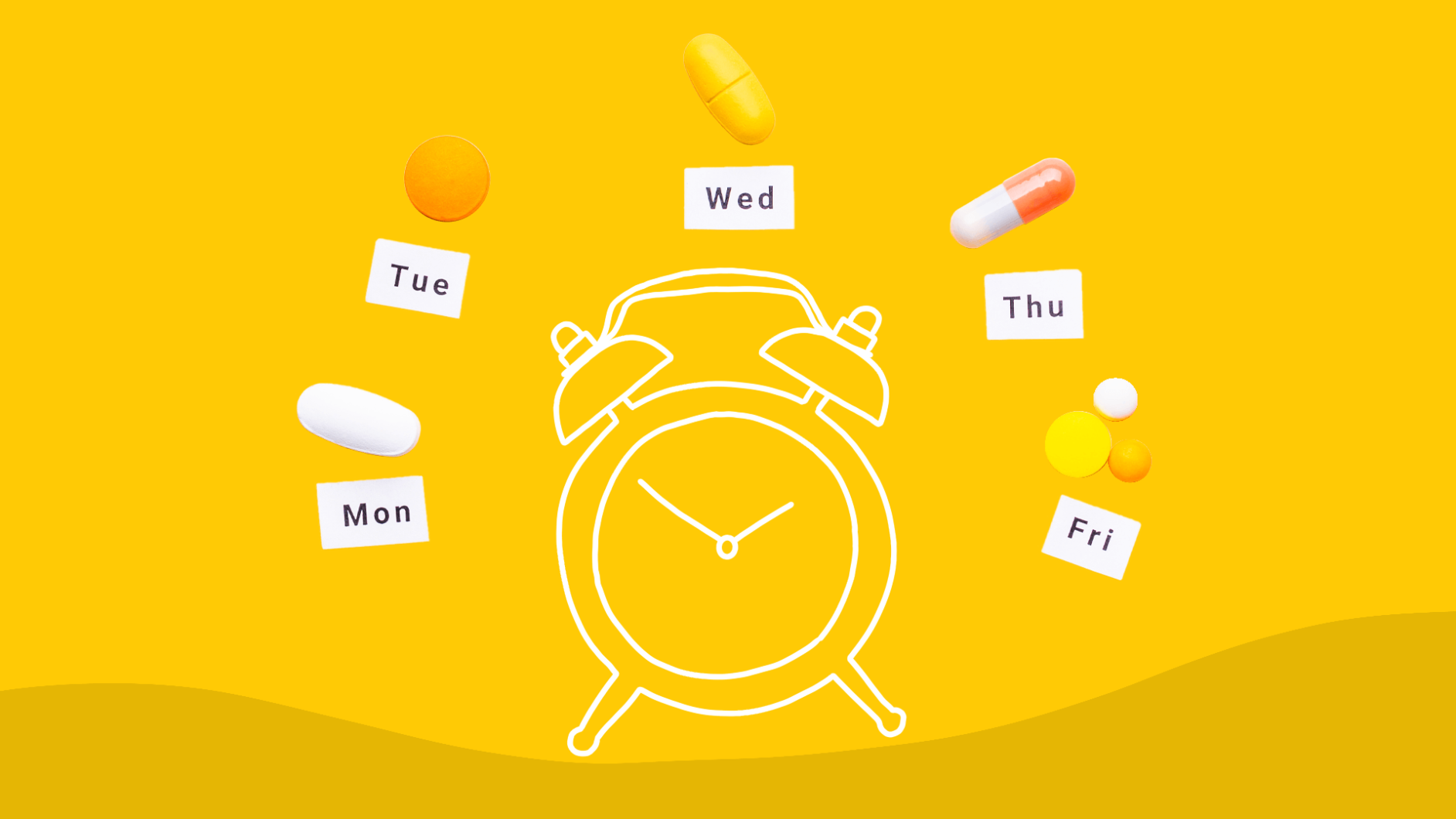Learning how to properly keep track of and manage medications is one of the most important things a patient or caregiver can do. Taking and managing medications may seem easy, but can quickly become complicated and lead to medication errors. Medication errors, such as taking the wrong dose of a medication or taking a medication at the wrong time, are extremely common and can lead to serious side effects, hospitalizations, and even death.
This article gives an overview of how to use personal medication list templates to make medication management easier, including caregiver checklists, weekly medication trackers, side effects trackers, patient medication feedback trackers, and a medication inventory template.
Why is medication management important?
Taking the right dose of medication at the right time of day is extremely important. Proper medication management helps ensure medications are working how they should be to treat injuries, illnesses, and diseases.
“Medication management service aims to help patients, seniors, and those in assisted living settings take the correct medicine and dose at the right time,” says David Clark, a lawyer and partner at The Clark Law Office, a personal injury law firm in Michigan. “Research shows that around 50% of patients mismanage [their] medications. The United States government considers medication management so important it has federal and state laws that regulate medicine use. The Food and Drug Administration has issued black box warnings to indicate serious adverse reactions that could result from taking certain medications. Even over-the-counter medications are regulated to ensure they are used as directed.”
Keeping close track of medications can prevent injuries, illnesses, and unnecessary side effects. Medication logs make it easy to prevent medication errors.
RELATED: Medication error statistics
How to create a medication list
Medication lists, medication schedule templates, and log sheets can be easy to create with a little free time and creativity. A good medication list will allow a patient or caregiver to track multiple medications and allow room to track how much of a medication to take, how often to take it, and when to take it. Websites like Canva can be great for creating medication list templates, and Microsoft Excel can be useful too.
If you’re short on time or don’t feel like creating your own template, check out the templates below. These free printable medication list templates were created by SingleCare to help patients and caregivers easily and properly manage medications.
5 free medication list templates
The following templates are free to download and print. To download a template in a PDF format, simply click on “DOWNLOAD THIS TEMPLATE FOR FREE” and save the template to your phone or desktop.
1. Caregiver checklist
A caregiver’s duties and responsibilities may include managing and keeping track of someone’s medical information, personal care, physical therapy, activities, exercise, meals, medications, or even the frequency of their bowel movements and urination. A caregiver is any person that is responsible for looking after a patient, and it can also be a patient’s family member or loved one.
The caregiver checklist linked below makes it easy to keep records of any tasks that need to be performed in order to care for a patient. It’s especially helpful for in-home caregivers because it includes a log for housekeeping tasks, but it can be used by all caregivers. The caregiver checklist also includes a section where caregivers can jot down notes like doctor’s phone numbers or emergency contact information, or the date and time of upcoming doctor’s appointments. Caregivers could even use this space as a log for tracking blood sugar or blood pressure levels. Staying organized can help caregivers avoid burnout, and this checklist makes it easy to manage someone else’s medications and daily activities to keep them as healthy as possible.
 DOWNLOAD THIS TEMPLATE FOR FREE
DOWNLOAD THIS TEMPLATE FOR FREE
2. Medication tracker
This medication tracker is helpful for patients, caregivers, and healthcare providers. It allows people to track medications that must be taken daily and/or weekly and can track four medications for up to a month. It allows someone to track which medications must be taken, the day and time they must be taken, and how much of each must be taken.
In the current age of digital technology, it may seem antiquated to use a printable tracker, especially since there are so many mobile apps that can be used to do the same thing. Certain apps can help set important reminders and function as a medication log, but printable tracker sheets can still be useful. Some patients are unable to use technology and need a hard copy to keep track of their medications and medical records. Printable trackers can also be nice for caregivers who have multiple patients because they can be placed in easy-to-see places like bedside tables, wall panels, or refrigerators.
No matter what your preference is, using a weekly medication tracker is a great way to keep track of your daily medications to ensure you’re taking them consistently over time. This is one of the best ways to prevent medication errors. ![]()
DOWNLOAD THIS TEMPLATE FOR FREE
3. Side effects tracker
Some medications cause initial side effects that will resolve on their own, while others can cause persistent side effects that require medical attention. Tracking side effects will help someone determine if a medication is right for them. If the side effects of a drug become too severe, it may be time to switch medications. Another reason to use a side effects tracker is to be able to share experienced side effects with a doctor. If a patient keeps detailed notes on the side effects they experience, their doctor will be able to tell them if what they’re experiencing is normal.
Medication side effects typically go away within a few weeks, but everyone is affected by medications differently. It’s possible for one person to have side effects that last a few days and for another person to have side effects that never completely go away. The important thing is to keep a medicine list and be aware of side effects that may require medical attention, such as:
- Difficulty breathing
- Swelling of the face, throat, or neck
- Confusion
- Trouble speaking
- Difficulty understanding speech
- Numbness or weakness on one side of the body
- Chest discomfort
- Severe abdominal pain and/or vomiting
- Mood changes
- Suicidal thoughts or behaviors
If you experience severe side effects while taking medication, it’s best to seek medical attention right away and talk with your doctor about whether or not the drug you’re taking is right for you. This list of severe side effects is not comprehensive. For a complete list of potential drug side effects, talk with your doctor or pharmacist.
The free printable side effects tracker linked below is available for instant download. It’s best for tracking the effects of only one medication at a time whereas the next template (a medication feedback form) can be used for multiple medications.
DOWNLOAD THIS TEMPLATE FOR FREE
4. Medication feedback form
This medication feedback form is best for tracking the side effects of multiple medications. It allows a patient, caregiver, or healthcare provider to track the side effects of up to 12 prescription drugs. It has space for the name of each drug, the dosage, the date the medication was started, and any side effects the patient experiences.
Tracking side effects is especially important for anyone taking or administering multiple medications because it’s possible for medications to interact with one another and cause adverse effects. Even though doctors try their best not to prescribe someone multiple medications that might interact, there’s always the potential for a drug interaction to occur. If someone keeps track of their medical history and side effects they’re experiencing in a medication chart, their doctor will be able to fine-tune the treatment plan to make sure the patient is getting the best treatment possible. 
DOWNLOAD THIS TEMPLATE FOR FREE
5. Medication inventory template
Over time, medications can become less effective (and possibly dangerous) if they expire. The following inventory template can be helpful for anyone who wants to track what they have in their medicine cabinet, including over-the-counter drugs and vitamins, to make sure they haven’t expired. It’s also helpful to track how much of each medication or supplement a person has on hand.
 DOWNLOAD THIS TEMPLATE FOR FREE
DOWNLOAD THIS TEMPLATE FOR FREE
It’s important to note that there’s no one-size-fits-all solution for effective medication management. If a downloadable template works for you, that’s great. But if an app is what’s going to get you to manage your medications more effectively, then go with that instead. At the end of the day, the goal is to reduce the risk of medication errors by keeping track of when and how a medication should be taken.











